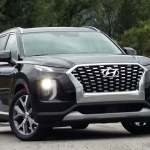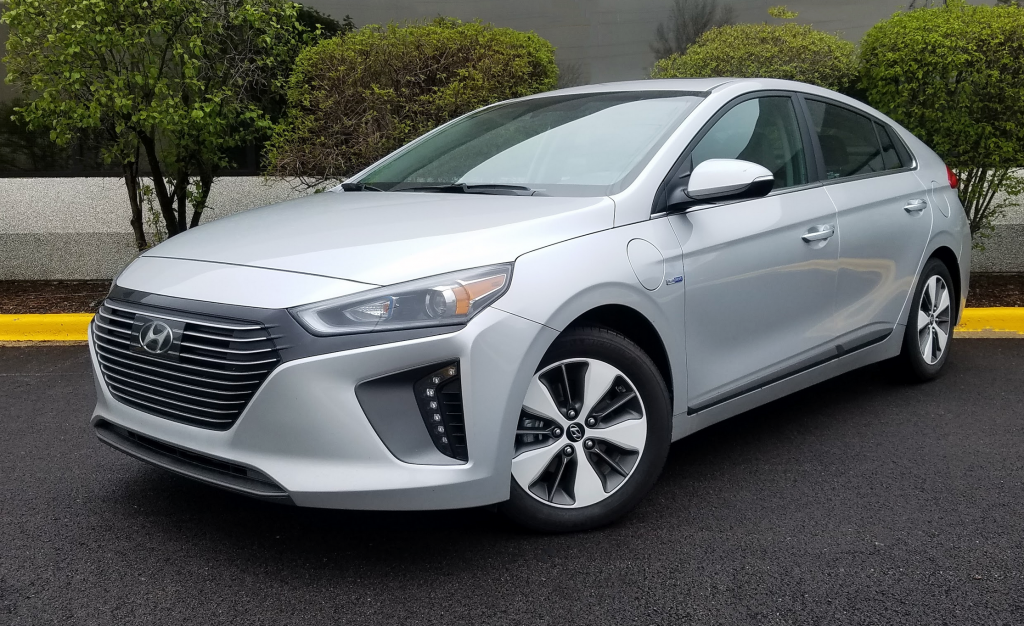
 2019 Hyundai Ioniq Plug-In Hybrid Limited
2019 Hyundai Ioniq Plug-In Hybrid Limited
Class: Compact Car
Miles Driven: 337
Fuel Used: 4.2 gallons
| CG Report Card | |
|---|---|
| Room and Comfort | B+ |
| Power and Performance | C+ |
| Fit and Finish | B |
| Fuel Economy | A+ |
| Value | B |
| Report-card grades are derived from a consensus of test-driver evaluations. All grades are versus other vehicles in the same class. Value grade is for specific trim level evaluated, and may not reflect Consumer Guide's impressions of the entire model lineup. | |
| Big & Tall Comfort | |
| Big Guy | A |
| Tall Guy | B+ |
| Big & Tall comfort ratings are for front seats only. "Big" rating based on male tester weighing approximately 350 pounds, "Tall" rating based on 6'6"-tall male tester. | |
| Drivetrain | |
| Engine Specs | 139-hp 1.6L |
| Engine Type | 4-cyl plug-in hybrid |
| Transmission | 8-speed automatic |
| Drive Wheels | Front-wheel drive |
Real-world fuel economy: 80.2 mpg
Driving mix: 65% city, 35% highway
EPA-estimated fuel economy: 119 MPGe/52 mpg (city/highway combined)
Fuel type: Regular Gas
Base price: $29,350 (not including $885 destination charge)
Options on test car: Ultimate Package ($2975), carpeted floor mats ($125)
Price as tested: $33,335
Quick Hits
The great: Fuel economy; comfortable cabin
The good: Simple, straightforward control layout with helpful eco-driving aids
The not so good: Rear visibility, price premium over “regular” Ioniq Hybrid
More Ioniq price and availability information
John Biel
Electrified motoring is the Hyundai Ioniq’s thing. The compact hatchback’s offerings run from a gas/electric hybrid to a fully electric version, and everything in between.
“Everything in between” happens to be a plug-in hybrid, which was added for 2018, the Ioniq’s second year on the market. Both hybrid variants combine a 1.6-liter 4-cylinder gas engine with an electric motor, a powertrain that generates 139 system horsepower. Note, though, that the plug-in has a larger electric motor that feeds off an 8.9-kWh lithium-ion polymer battery, which permits the car to be driven an estimated 29 miles solely on electric power.
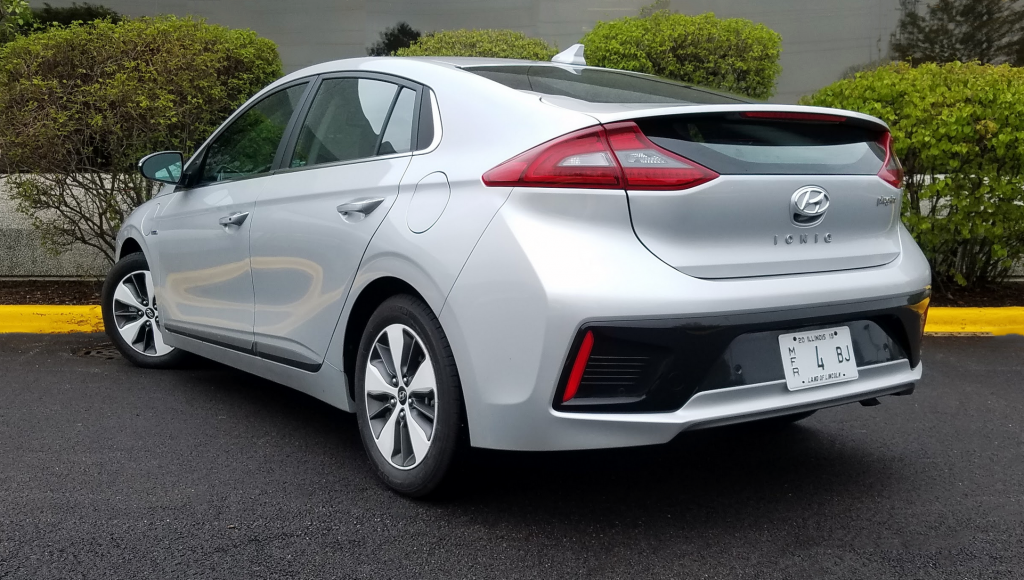
Like the Ioniq Electric—the sale of which is limited to 10 coastal states—the broadly available Plug-in is presented in two trim levels, base and Limited. Consumer Guide tested a Limited that was priced at $30,235 with delivery to start, but reached $33,335 with carpeted floor mats and Ultimate Package option group. As a partial-electric vehicle, the Plug-in is subject to a $4543 federal tax credit.
Quick Spin: 2018 Hyundai Ioniq Hybrid

The few changes to the ’19 Ioniq do make themselves felt in the Plug-in. A new driver-attention alert system is standard on the Limited (but is not available on the base car), and new automatic high-beam headlights are included in the Ultimate Package option.
Test Drive: 2018 Mini Cooper Countryman Plug-In Hybrid

EPA overall fuel-economy projections for the Ioniq Plug-in are 119 MPGe, with a gas-consumption rate of 52 mpg. This driver toggled between all-electric and hybrid drive modes—generally reserving the former for the surface-street portions of his daily commute and using the latter on expressways—and recorded gas use of 60.6 mpg after 220 test miles. (Sixty percent of the stint was carried out in lower-speed driving conditions.) A subsequent test session with shorter trips and more plugging in (thus maximizing pure-electric operation) bumped up our overall average to an impressive 80.2 mpg. Range between fill-ups exceeds 600 miles.
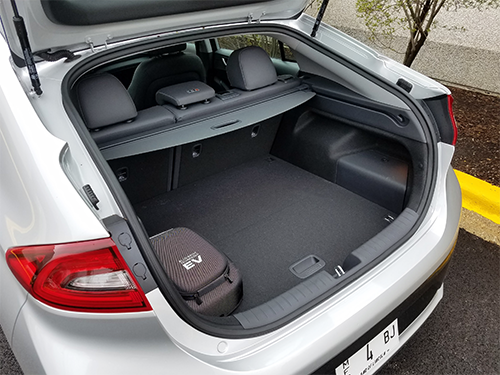
We found the Plug-in would not allow selection of full-electric mode once the battery had dropped to around 15 percent of capacity. With a 240-volt “level-2” charger, full recharge from that point takes an indicated 2.5 hours. Operating as previously described on commutes of approximately 28 miles each way, this reviewer was able to make three trips before needing to recharge to regain full-EV capability.
As an electric, the Ioniq Plug-in is responsive at launch and quiet always. As a hybrid, it is unremarkable in power delivery, but never truly overmatched for on-ramp merging or expressway cruising. While a lot of hybrids and other economy-oriented small cars have gravitated to continuously variable transmissions prone to leisurely power distribution, the Plug-in sports a 6-speed automated-manual transmission with “normal” stepped upshifts that spare the car from droning on as it gradually attains something akin to speed. Plus, steering-wheel-mounted paddle shifters give drivers some say in how the car performs.
Ride quality suffers a little on choppy pavement, but is generally agreeable. Steering is light, and lacking somewhat in road feel, but it’s still as maneuverable as many other cars of its size. The Ioniq is prone to the soft initial braking common to hybrids and electrics that use regenerative braking to capture energy that can be returned to the battery.
The Ioniq Plug-in Limited pastes a veneer of luxury over its economy underpinnings. The seats and the tilt-and-telescoping steering wheel are clad in leather. Front seats are heated, and the driver’s seat is power adjustable. There’s an auto-dimming rearview mirror, a proximity key with push-button starting, and automatic temperature control, too. The audio system includes satellite and HD radio. Apple CarPlay/Android Auto smartphone connectivity is part of the infotainment complement. Standard wheels are 16-inch alloys. Headlights and taillights are LED. Tech touches encompass Bluetooth hands-free phone capability, Hyundai Blue Link telematics, adaptive cruise control, blind-spot detection with rear cross-traffic alert, automatic emergency braking, and lane-keeping assist.
Test Drive: 2019 Mitsubishi Outlander PHEV

Further deluxe touches are included in the $2975 Ultimate Package. To “fun” features like a power sunroof, memory driver’s seat, and 8-speaker Infinity audio upgrade, it adds dynamic-bending headlights, rear parking sensors, navigation with an 8-inch touchscreen, wireless device charging, and additional Blue Link capability.
Passenger space is good for the class, with a rear seat wide enough and comfortable enough to accommodate perhaps three teenagers. Driver vision is good most everywhere but, perhaps, to the rear corners. The rear window slopes down to the end of the car, then continues in the vertical space between the taillights. However, like so many other such designs, a rear “spoiler” runs between the panes, obstructing the straight-back view. Drivers face a 7-inch instrument-cluster display with a 4.2-inch trip-computer read-out and graphs that report on the hybrid’s driving-power and battery-charge levels. Audio, climate, and navigation controls display well, and are convenient to reach and use.
For personal-item storage, the cabin boasts a sizeable glove box, a deep covered console box, door pockets, and pouches on the backs of the front seats. Cup holders are found the console and the pull-down rear armrest. Good cargo space exists on a flat floor under the hatch. When additional room is needed, the rear 60/40-split seats fold, though they don’t drop completely flat, and there’s a small gap between them and the cargo floor.
With the Ioniq product line, Hyundai has forcefully jumped into the electrified-vehicle market. The Plug-in makes sure it has all the bases covered.
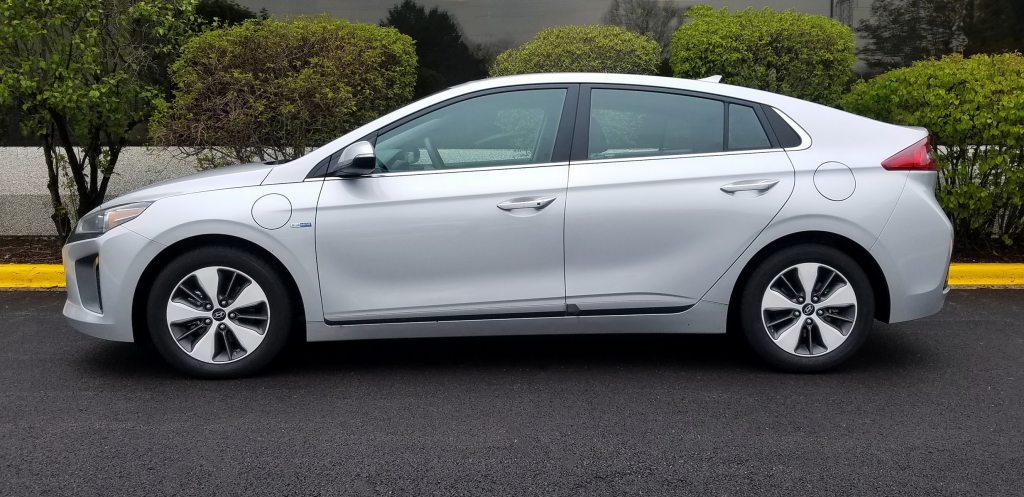
9 Electric Car Companies To Watch
2019 Hyundai Ioniq Plug-In


